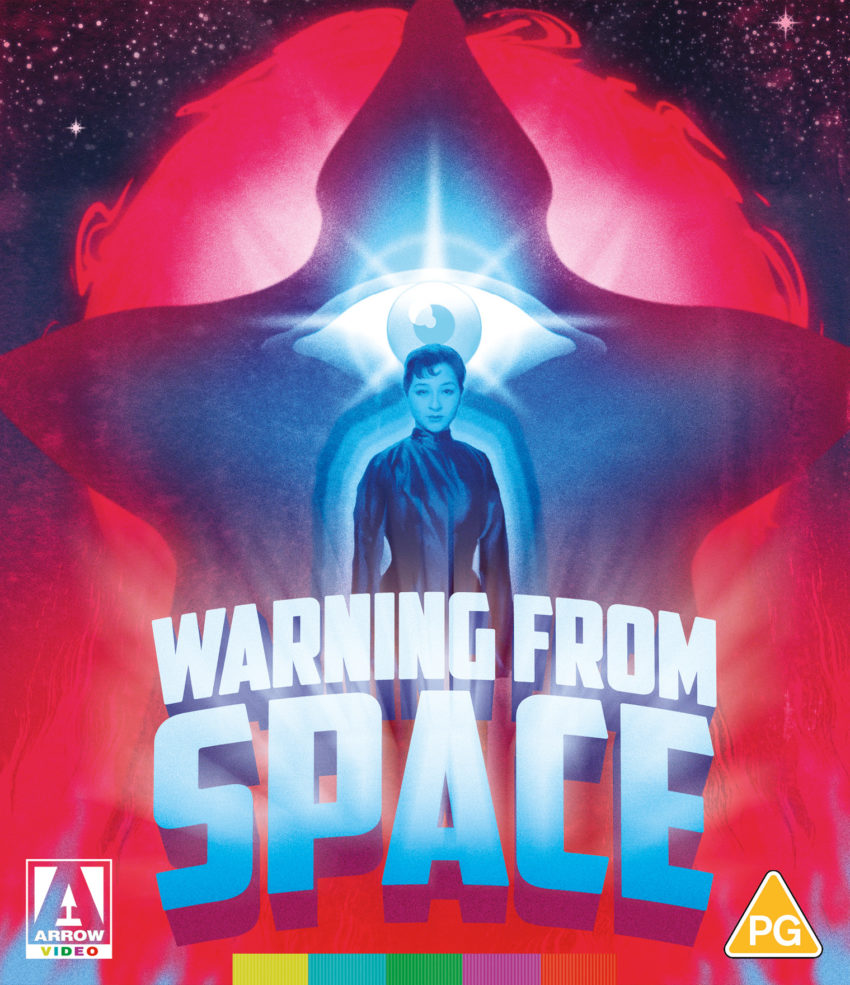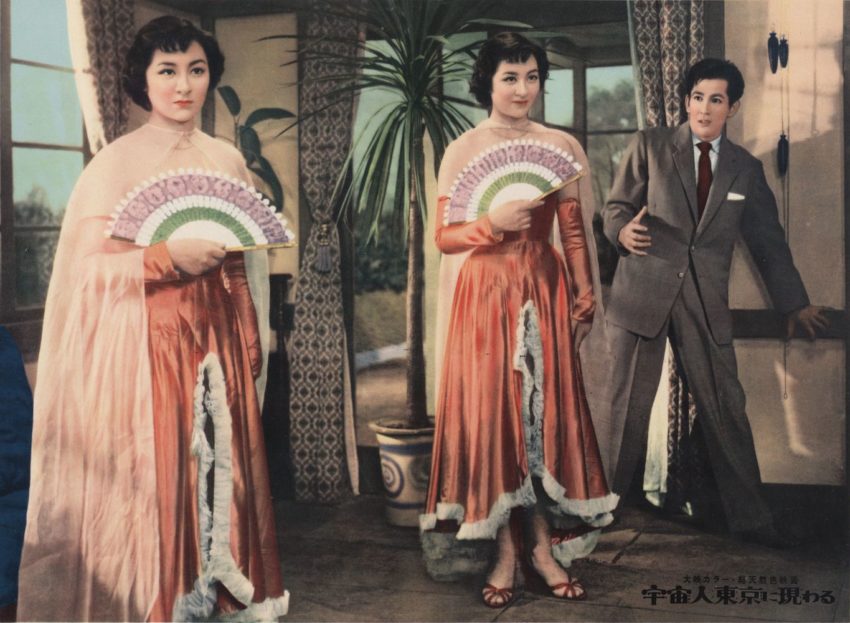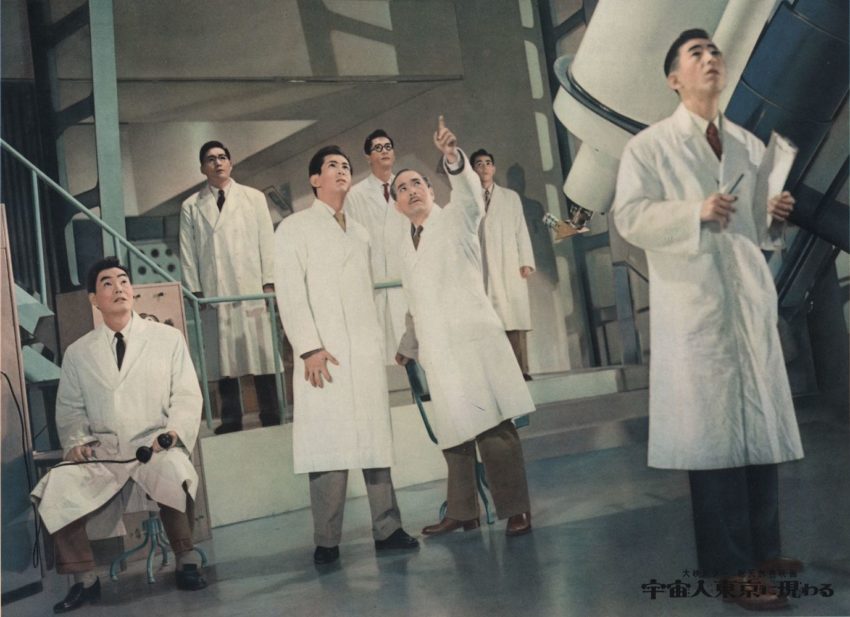Warning from Space
November 17, 2020 · 0 comments
by Jeremy Clarke.
The first Japanese science fiction film to be made in colour, Warning from Space (1956) features peaceful, star-shaped aliens, one of whom transforms herself into a nightclub singer to make contact with Japanese scientists. Not that the aliens possess any discernible gender themselves, but the human likenesses into which they are transformed most definitely do. If you watch the original Japanese version, the aliens’ transformation into human form doesn’t take place until a third of the way in. When the Americans got hold of the film, they not only dubbed it into English, but also did some deft re-editing to create new opening and closing sequences so that the film now both starts and ends inside the alien ship. The closing sequence is basically the transformation sequence backwards.
On their ship, the aliens as designed by avant-garde artist Taro Okamoto are actors in five-pointed star suits, which to Western eyes, used to special effects aimed at photorealism, looks as completely bonkers as it sounds. The accompanying booklet, sadly not sent to journalists with Arrow’s review disc, apparently contains some writing about Okamoto.
We only ever see one alien being transformed. A star suit gets into a circular chamber which closes with two doors that resemble circular glass lenses. Lap dissolves on a shot framing the top of the star suit show a series of static clay models increasingly resembling a generic human head and shoulders. Then the head and shoulders of actress Toyomi Karita appear, augmented with clay so that her facial features can’t yet be seen until finally we glimpse the face of the actress herself. In an attempt to make all this even more impressive, a double-exposed image of what appears to be a coloured spring moves up and down over these visuals.

As well as the alien in human form, Ginko, Karita also plays glamorous nightclub singer Hikari Aozora who gets a complete song and dance routine on a stage with a chorus line before she glimpses one of the star-shaped aliens, causing herself and the cast to immediately flee. On a later occasion, she’s interviewed backstage by a journalist about the fact that the alien is her spitting image and she collapses, never to be seen in the film again. Many of the characters in the film are like this – they start off promisingly enough, but then it’s as if director Koji Shima can’t be bothered to develop them any further; the film moves on to introduce other characters to whom the same thing happens. Shima had a prolific career first as an actor in 79 films between 1925 and 1937, then as a director of some 61 more movies between 1940 and 1970. He was clearly reliable and got the job done, even if in this case the final result is solid rather than ground-breaking.
The lack of script development is surprising when you look at the pedigree of the scriptwriter. Hideo Oguni, who worked on the highly regarded Where Chimneys Are Seen (1953), is best known for his work on numerous Akira Kurosawa movies including Ikiru, Seven Samurai, Hidden Fortress, Throne of Blood, Sanjuro and Ran (all currently still available on BFI Player as part of Japan 2020). According to film historian Stuart Galbraith’s commentary, which only runs a mere 60-odd minutes, Kurosawa would let about four writers write each scene, then they’d all compare notes. Sometimes Kurosawa would use one scene as written by one writer, sometimes he’d use elements of different versions. Kurosawa’s movies never suffered from underdevelopment the way Warning from Space does.
Likewise, there are two young leads, male and female, Dr Toru Itsobe (Keizo Kawasaki) and Taeko Kamura (Mueko Nagai), the son and daughter of two older (male) scientist characters the elder Dr Itsobe (Shozo Nanbu) and Dr Kamura (Bontaro Miyake). There’s an additional older scientist Dr Matsuda (Isao Yamagata). The two young leads look like they’re going to be significant, but their characters don’t really go anywhere as the subsequent plot moves between the three elder scientists. You won’t care about any of them. The alien Ginko is presented as The Other, so we don’t really get to know her, either. We know even less about her three alien companions, transformed into human males and referred to as numbers two, three and four. Curiously, actor Bin Yagisawa who plays the minor character of Number Two appears third on the bill. Even more sketchy is the bad alien who tries to buy from Dr Matsuda the formula for Urium, an element he’s discovered which is capable of being developed into a weapon far more powerful than the atomic bomb.

Japan being the one nation on earth to suffer the effects of nuclear weaponry, the aliens head there to reveal the threat of a distant planet called R approaching Earth on a collision course, a plot device that may have been inspired in part by George Pal’s science fiction epic When Worlds Collide, released in Japan in 1952. The Japanese then have to talk to the World Council, a script stand-in for the UN, of which Japan was not yet then a member. The plan is that the other nations need to decide jointly to fire missiles at R to destroy it. First, Japan has to wait for their decision.
Yet for all its faults, the film has both charm and durability. The colour cinematography, very much a novelty in Japan at the time, looks great. Scenes at train stations and bars jostle with kindergartens and people’s homes, although the most memorable set must be the observatory with its giant telescope and its basement where scientist and nursery children shelter towards the end as the Earth heats up pending R’s impact. Ginko is fascinating too, not so much as a barely developed character but in terms of her ability to do things like effortlessly rise six feet into the air to return a volley during a tennis match or walk through walls by fading out to reappear on the other side.
The film was made at Daiei, the Studio that would later go on to make the highly successful Gamera movies. It never reached cinemas in the US, but had something of a life on broadcast television there, so its current release in both longer American and original Japanese versions is a first. It’s a key work in the history of Japanese science fiction cinema and consequently a most welcome release.
Warning from Space is released on Arrow Blu-ray. Jeremy Clarke’s new website is jeremycprocessing.com

Leave a Reply